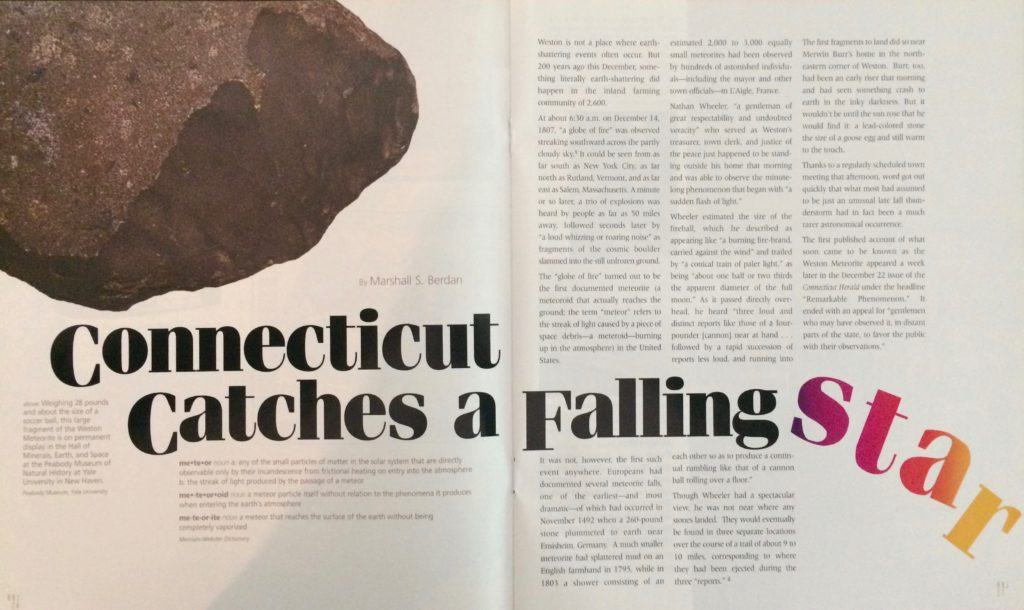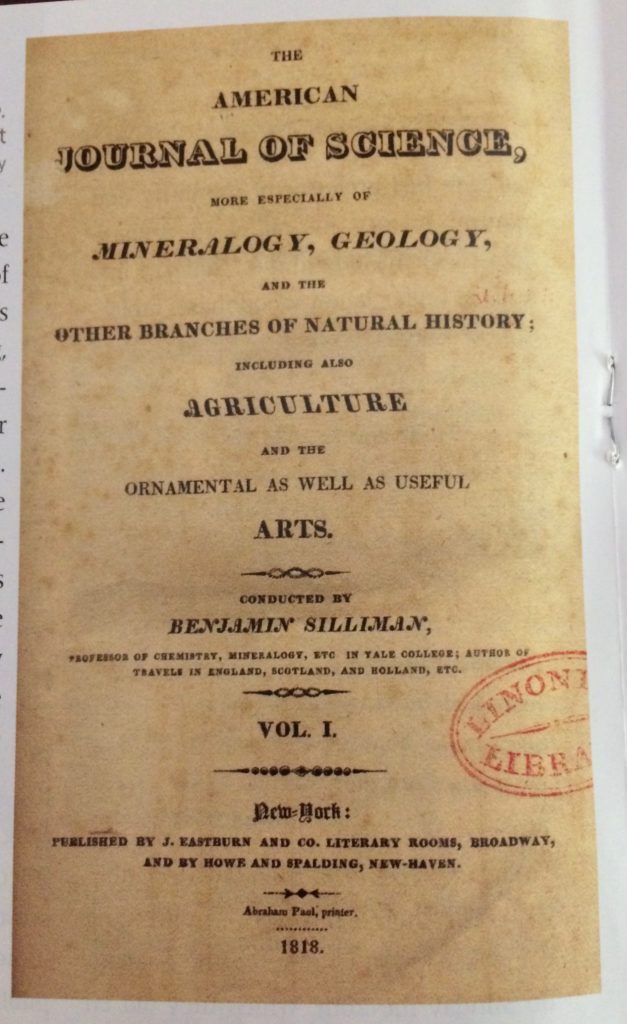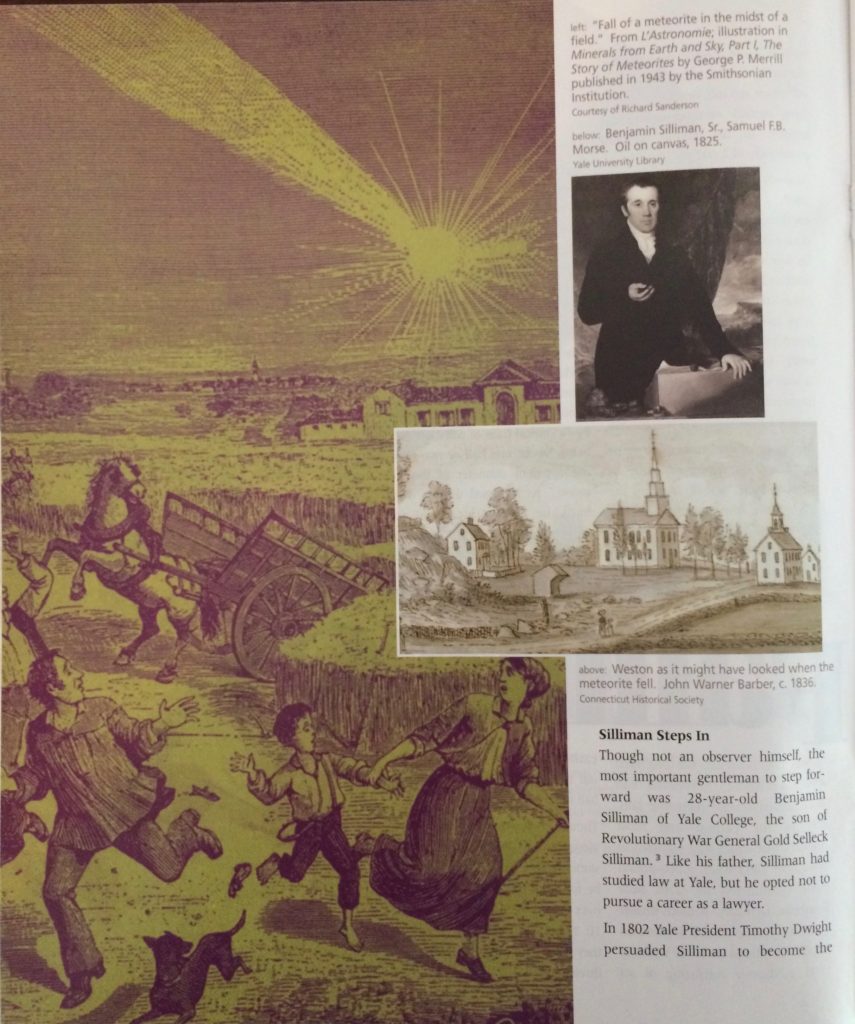
Large fragment, Peabody Museum of Natural History, Yale University. “Connecticut Catches a Falling Star,” Connecticut Explored, Winter 2007-2008
by Marshall S. Berdan WINTER 2007/08
Weston is not a place where earth-shattering events often occur. But 200 years ago this December, something literally earth-shattering did happen in the inland farming community of 2,600.
At about 6:30 a.m. on December 14, 1807, “a globe of fire” was observed streaking southward across the partly cloudy sky.[1] It could be seen from as far south as New York City, as far north as Rutland, Vermont, and as far east as Salem, Massachusetts. A minute or so later, a trio of explosions was heard by people as far as 50 miles away, followed seconds later by “a loud whizzing or roaring noise” as fragments of the fireball slammed into the still unfrozen ground.
The “globe of fire” turned out to be the first documented meteorite (a meteor that actually reaches the ground; the term “meteor” refers to the streak of light caused by a piece of space debris—a meteoroid—burning up in the atmosphere) in the United States.
It was not, however, the first such event anywhere. Europeans had documented several meteorite falls, the earliest—and most dramatic—of which had occurred in November 1492 when a 260-pound stone plummeted to earth near Ensisheim, Germany. A much smaller meteorite had splattered mud on an English farmhand in 1795, while in 1803 a shower consisting of an estimated 2,000 to 3,000 equally small meteorites had been observed by hundreds of astonished individuals—including the mayor and other town officials—in L’Aigle, France.
Nathan Wheeler, “a gentleman of great respectability and undoubted veracity” who served as Weston’s treasurer, town clerk, and justice of the peace just happened to be standing outside his home that morning and was able to observe the minute-long phenomenon that began with “a sudden flash of light.”
Wheeler estimated the size of the fireball, which he described as appearing like “a burning fire-brand, carried against the wind” and trailed by “a conical train of paler light,” as being “about one half or two thirds the apparent diameter of the full moon.” As it passed directly overhead, he heard “three loud and distinct reports like those of a four-pounder [cannon]near at hand . . . followed by a rapid succession of reports less loud, and running into each other so as to produce a continual rumbling like that of a cannon ball rolling over a floor.”
Though Wheeler had a spectacular view, he was not near where any stones landed. They would eventually be found in three separate locations over the course of a trail of about 9 to 10 miles, corresponding to where they had been ejected during the three “reports.”[2]
The first fragments to land did so near Merwin Burr’s home in the northeastern corner of Weston. Burr, too, had been an early riser that morning and had seen something crash to earth in the inky darkness. But it wouldn’t be until the sun rose that he would find it: a lead-colored stone the size of a goose egg and still warm to the touch.
Thanks to a regularly scheduled town meeting that afternoon, word got out quickly that what most had assumed to be just an unusual late fall thunderstorm had in fact been a much rarer astronomical occurrence.
The first published account of what soon came to be known as the Weston Meteorite appeared a week later in the December 22 issue of the Connecticut Herald under the headline “Remarkable Phenomenon.” It ended with an appeal for “gentlemen who may have observed it, in distant parts of the state, to favor the public with their observations.”
Silliman Steps In
Though not an observer himself, the most important gentleman to step forward was 28-year-old Benjamin Silliman of Yale College, the son of Revolutionary War General Gold Selleck Silliman.[3] Like his father, Silliman had studied law at Yale, but he opted not to pursue a career as a lawyer.
In 1802 Yale President Timothy Dwight persuaded Silliman to become the college’s first professor of chemistry and natural history instead. To prepare himself for his new duties, Silliman first studied under James Woodhouse, professor of chemistry at the University of Pennsylvania, and then at the University of Edinburgh, where he was introduced to meteorites. Little could he have known that nine years later one of these rare astronomical events would secure his reputation as one of the foremost scientists of the young nation.
Upon hearing the first reports of the meteorite, Silliman set off to Weston, accompanied by James L. Kingsley, a Yale professor of religious studies. Though the distance was only 25 miles, the pair wouldn’t arrive until Monday, December 21, as their religious upbringing compelled them to observe the Sabbath on Sunday the 20th, which they did en route in Fairfield, Silliman’s hometown.
The two professors spent the next two days interviewing “all the principal original eyewitnesses” and collecting “by importunity and purchase” a “considerable number of specimens.” Their report, which would be revised and republished several times over the next few years, is still the most complete description of the Weston Meteorite.
In addition to Nathan Wheeler and Merwin Burr, Silliman and Kingsley collected eyewitness accounts and samples from other townspeople. Five miles south of Merwin Burr’s farm, William Prince, one of early Weston’s wealthiest residents, testified to having been roused from his bed by a flash of light and observing a patch of smoking ground, the results, he assumed, of a lightning strike. Upon inspection later that day, however, he found a 35-pound meteorite, sunk two feet in the ground. Hoping that it contained gold or silver, the avaricious Prince broke it up with a hammer and melted the fragments at a blacksmith’s forge. When it was clear that they contained nothing that he considered valuable, he sold the remaining 12-pound piece to Isaac Bronson, a friend and former roommate of Silliman’s.
The single largest fragment appears to have landed some 500 feet from Elijah Seeley’s farmhouse in Trumbull, four miles farther south. Seeley, who had been indoors at the time, also attributed the bright light and loud noise to lightning, only to discover later that several of his cows had jumped into the adjacent enclosure and that “all exhibited strong indications of terror.” (Subsequent published embellishments would have Seeley actually milking his cows when the meteorite landed only fifty feet away.)
Unfortunately, this meteorite struck a fieldstone embedded in the earth, shattering both objects to smithereens, most of which would be carried away by curious neighbors. Judging by the size of the hole in the ground (five feet in length, four and a half feet wide, and three feet deep), Silliman estimated that this particular fragment must have weighed nearly 200 pounds.
But the two Yale professors were to return to New Haven with at least one sizeable treasure. Less than half a mile from the Prince homestead, a 13-pound fragment had landed in an unidentified farmer’s field, splitting into two roughly equal halves. Silliman was able to purchase the smaller, six-pound half for a price he never disclosed.
Reporting to the World
Back in his basement laboratory, Silliman began analyzing his specimens, which he soon concluded to be composed of “51.5% silex, 38% brown oxid [sic]of iron, 13% magnesia, 1.5% oxid of nickel, and 1% sulphur, with the excess . . . proceed[ing]manifestly from the oxidizement of the iron, in a considerable, but unknown proportion.” Time was of the essence: the meteorite had attracted the attention of several amateur and professional men of science, including Silliman’s former instructor James Woodhouse. As the first scientist on the scene, Silliman was clearly in the best position to stake a scholarly claim to the meteorite, but until he conclusively did so, “ownership” of the Weston Meteorite remained up for grabs.

Cover page of the first issue of the American Journal of Science, founded by Benjamin Silliman Sr in 1818. Yale University Library. “Connecticut Catches a Falling Star,” Connecticut Explored, Winter 2007-2008
Silliman and Kingsley’s first report, a summary of the eye-witness accounts accompanied by the preliminary results of Silliman’s chemical analysis, appeared in the December 29 issue of the Connecticut Herald and put the team on record as the first scientists to present findings about the meteorite. The report was reprinted in the January issue of Churchman’s Magazine (whose subtitle identified it as a “Treasury of Divine and Useful Knowledge”), this time with a preamble designed to pre-empt alternative accounts.
As imperfect and erroneous accounts of the late phenomenon at Weston are finding their way into the public prints, we take the liberty of enclosing for your paper, the results of an investigation into the circumstances and evidence of the events referred to, which we have made on the ground where it happened.
The publication’s editor, Rev. Tillotson Bronson (no known relation to Isaac Bronson), nonetheless pontificated on the meteorite’s ultimate significance:
As Christians we believe that all events in the natural world are subject to the control of Almighty Power. . . . But what is this compared with the events of the last great day when planets and suns shall be hurled from their spheres and the earth not only shaken, but from her centre torn to be involved in flames and dissolved into smoke and vapors? . . . Think of this, O Christian! and consider what manner of person thou oughtest to be, in all holy conversation and godliness. [his emphasis]
Silliman, still on the lookout for additional specimens, received some welcome news from his friend Isaac Bronson: a 36½-pound fragment had been found atop Tashua Hill in Trumbull by the son of a Mr. Jennings of Fairfield. Bronson reported, however, that “it will require some address to get it from [the father]as he seems to entertain extravagant ideas of the value of his prize.” Having refused the $5 that Bronson had offered, Jennings eventually took his treasure to New York City, where he exhibited it for money.
Meanwhile, Silliman set about producing an even more comprehensive report for the world scientific community, which was still very much divided about the nature and origin of comets, meteors, and other non-planetary objects. Silliman concluded that the meteorite couldn’t have come from any of the widely suspected sources such as stones fused by lightning, terrestrial volcanoes, a coalescence of atmospheric gases, or projectiles from lunar volcanoes. Assuring their readers that the Weston Meteorite was extraterrestrial in nature, the authors went on to tentatively accept the “terrestrial comet” theory proffered by the then-late Thomas Clap (president of Yale from 1739 to 1766), who, according to which such bodies “revolv[ed]around the earth in the same manner as the solar comets revolve around the sun.”
The completed report was sent to the Philosophical Society of London and the Academy of Sciences in Paris, the western world’s two pre-eminent scientific academies, both of which would publish it to widespread notice and acclaim.
For the domestic market, Silliman and Kingsley toyed briefly with Isaac Bronson’s proposal of publishing and selling a popular tract for $1 per copy under the premise that it would “bring [them]a sum equal to a year’s salary.” Eventually, however, they submitted their revised comprehensive report to America’s leading scientific body, the American Philosophical Society in Philadelphia. At the conclusion of the academic term in February, Silliman hand delivered the document to Philadelphia, where it was formally read at the Society’s March 4, 1808 meeting. For all practical purposes, the Weston Meteorite now “belonged” to Yale’s Benjamin Silliman.
Later that year, Kingsley was replaced as co-author by Jeremiah Day, professor of mathematics and natural philosophy, who contributed a new projection of the dimensions of the original object: a diameter of no less than 491 feet and a weight of some six million tons. He also revised the projection of the meteorite’s velocity to 3 miles per second based largely on the observations of an additional eyewitness his brother had located in Hartford.
Interest in the Weston Meteorite rose to the highest levels of civil as well as scientific society. Apparently skeptical about the meteorite’s extraterrestrial origins, President Thomas Jefferson commissioned “the father of American navigation,” Nathaniel Bowditch of Salem, Massachusetts, to investigate. In his report, published in 1815, Bowditch effectively refuted the terrestrial comet theory, but corroborated Silliman and Kingsley’s extraterrestrial-origin conclusion.
But Bowditch introduced some serious inaccuracies of his own. Relying upon yet another eyewitness in Colchester (50 miles from Weston) who had also estimated the diameter of the meteorite to be half that of the moon, Bowditch concluded that the original fireball must have been at least several hundred feet in diameter and weighed nearly 600 tons. Even more errantly, Bowditch went on to posit that the meteor had only skimmed the earth’s atmosphere before caroming back into space.
In the meantime, Silliman continued to pursue his studies and the acquisition of more fragments, including the Jennings fragment. Jennings had hoped to get as much as $500 for his piece, but eventually settled for $130 from Colonel George Gibbs of Newport, the country’s foremost collector of minerals. In 1811, Gibbs lent Yale his extensive rock collection (some 12,000 specimens), and Silliman finally had access to the single largest fragment of the Weston Meteorite. (Fourteen years and many risky land speculations later, an impoverished Gibbs sold his entire collection to Yale for $20,000.)
The next year, Silliman began riding his assiduously cultivated expertise—and the Jennings/Gibbs fragment—to fame if not profit, lecturing throughout the Northeast with assorted specimens transported in a specially designed compartment underneath his carriage.
In 1818, he founded the American Journal of Science, which 189 years later continues to be the nation’s leading journal of geology and its longest continuously published scientific journal, period. “As a result, Yale became one of the pre-eminent scientific institutions in the mid-19th century,” explains Barbara L. Narendra, who since 1972 has served as manager of the Peabody Museum’s Meteorite Collection. In 1830, Silliman’s prestige lured 17-year-old James Dwight Dana to Yale. Dana, whose system of mineralogy is still in use today, would become the most prominent American geologist of the 19th century and the first Silliman Professor of Natural History and Geology. (He also became Silliman’s son-in-law.) Meanwhile, Silliman’s own son, Benjamin Jr., would inherit both his father’s interest in meteorites and his position as professor of chemistry.
Two centuries later, the Jennings/Gibbs Meteorite, now classified as an H4 stone chondrite and down to 28 pounds as a result of donations to other institutions—including the Smithsonian in Washington—is still at Yale, where it serves as the cornerstone of the Peabody’s extensive meteorite collection.
Are there still pieces of the Weston Meteorite just waiting to be found? “Probably,” says Narendra, who notes that of the 350 pounds the meteorite is now estimated to have weighed, only 50 can be accounted for. “But by now they are so weathered as to be indistinguishable from the millions of other stones lying all around.” Even so, she still gets the occasional call from someone believing that he or she has unearthed a long-lost fragment. So far, none has proven authentic.[4]
But despair not, souvenir hunters. Fragments of the Weston Meteorite periodically turn up on eBay, where the going price is roughly $100 a gram.
NOTES
1. All quotes, unless otherwise specified, are taken from “Memoir on the origin and composition of the meteoric stones which fell from the Atmosphere, in the County of Fairfield, and State of Connecticut on the 14th of December 1807; in a letter dated February 18th, 1808 from Benjamin Silliman, Professor of Chemistry in Yale College, Connecticut, and Mr. James L. Kingsley, to Mr. John Vaughan; Librarian of the American Philosophical Society” as published in Godon’s Meteorological Observations &c., No. LI, p. 323-345.
2. Of the three principal impact sites, two are located in what is now the town of Easton, the other in Trumbull. But until 1845, Easton was still a part of Weston. Hence, the famous Weston Meteorite didn’t actually fall in what is now the town of Weston.
3. Facts about the life of Benjamin Silliman come from various sources, but especially Chandos Michael Brown’s full-length biography Benjamin Silliman: A Life in the Young Republic, (Princeton University Press; Princeton, New Jersey, 1989).
4. Since 1807 there have been three subsequent witnessed meteorite falls in Connecticut: in Wethersfield in 1971, in Stratford in 1974, and again in Wethersfield in 1982.
The Peabody Museum of Natural History at Yale University, located at the intersection of Whitney Avenue and Sachem Street in New Haven, is open Monday through Saturday 10 a.m. to 5 p.m. and Sunday noon to 5 p.m. Call (203) 432-5050 or visit www.yale.edu/peabody.

